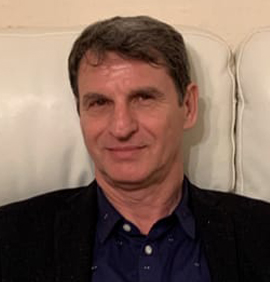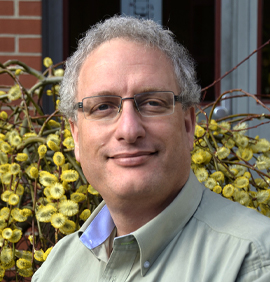 Palestra 8: Catalytic strategies for the conversion of CO2 into valuable products
Palestra 8: Catalytic strategies for the conversion of CO2 into valuable products
Resumo: CO2 capture and utilisation is a central research topic in the context of sustainability. The use of CO2 feedstock is attractive not only in order to decrease the concentration of this greenhouse gas in the atmosphere but also because CO2 is a non-toxic, inexpensive, widely-available, renewable and thus green C 1 feedstock. However, the conversion of CO2 into useful products is a challenging target, due to the high thermodynamic stability of this molecule. There are two main strategies to overcome this limitation: (i) provide energy, e.g. in the form of electricity (electrochemical conversion); (2) react CO2 with high free energy compounds (e.g. H2, epoxides, amines). In both cases, a catalyst is essential to improve the kinetics of the process and achieve the efficient conversion of CO2 into selected valuable products. In this presentation, you will hear about our recent research achievements in the context of CO2 conversion, using different catalytic approaches ranging from homogeneous to heterogeneous catalysis and finally touching electrocatalysis. For the conversion of CO2 into cyclic carbonates, we developed metal-free homogeneous and heterogeneous catalysts that enable the synthesis of the target products with high selectivity under mild conditions. The presentation will then delve into the conversion of CO2 into polycarbonates using heterogeneous catalysts and the challenges of the upscaling of the production of these polymers towards industrial scale. Finally, you will hear about the growing area of electrocatalysis for the reduction of CO2 into useful products, with a focus on formic acid synthesis.
Data: 29/09/2023
Horário: 9:00h
Currículo do Palestrante

 Palestra 2: Deoxygenation of Amides and Depolymerization of Polyesters and Polycarbonates via the Catalytic Regeneration of Metal-Hydride from Metal-Alkoxides
Palestra 2: Deoxygenation of Amides and Depolymerization of Polyesters and Polycarbonates via the Catalytic Regeneration of Metal-Hydride from Metal-Alkoxides
Resumo da Palestra: During the last decade, organoactinide-based complexes have received considerable attention from many scientific researchers. Such a profound interest reflects the principle that actinides possess a number of unique features that cannot be found among other transition metals. Among these unique features, is their very sizeable ionic radii, which gives rise to large formal coordination numbers and unusual coordination geometries. In addition, the presence of 5f valence orbitals is another characteristic of the actinides that differs distinctly from the d-block and the lanthanides elements, as it has been shown that these orbitals are partially responsible for metal reactivities (in contrast to the inert 4f orbitals of the lanthanides). Considering these differences, we will present how to design actinide catalysts to foster unique catalytic transformations; in the presentation, we will show:The effect of the ligand size (five, six, and seven-membered-ring N-heterocyclic iminato ligands) towards the reactivity of the complexes with oxygen-containing substrates. How to tailor a catalytic system for the selective 1,2-regioselective dearomatization of pyridines and other N-heteroaromatics via hydroboration. We will also present the catalytic deoxygenation of amides towards amines. Moreover, we will show how we depolymerize polyesters to the corresponding alcohols and the depolymerization of carbonates and polycarbonates to the corresponding diols and methanol.
Data: 26/09/2023
Horário: 9:00h
Currículo do Palestrante
 Palestra 1: Estudos cinéticos e espectroscópicos de mecanismos catalíticos: O método ACT (Análise de Cobertura Transiente) aplicado à hidrodesoxigenação de um composto modelo de biomassa
Palestra 1: Estudos cinéticos e espectroscópicos de mecanismos catalíticos: O método ACT (Análise de Cobertura Transiente) aplicado à hidrodesoxigenação de um composto modelo de biomassa
Resumo da Palestra: O estudo dos mecanismos de reação é uma área ativa da cinética química, embora seja geralmente aceito que os mecanismos não podem ser comprovados com base apenas na cinética. Este trabalho mostra que dados de reatividade, espectroscópicos e transitórios, podem ser combinados para fornecer uma imagem unificada de um mecanismo de reação. A reação estudada é a hidrodesoxigenação de um composto modelo líquido de pirólise, gama-valerolactona (GVL). Faz-se uso de espectroscopia no infravermelho in situ e espectroscopia de absorção de raios X in situ para sondar as espécies adsorvidas e a natureza da superfície do catalisador em condições de reação. Um novo método, chamado Análise de Cobertura Transiente (ACT) é usado para provar que uma espécie adsorvida é um intermediário real de reação. O método ACT é geral e pode ser usado com qualquer técnica espectroscópica.
A aplicação do trabalho está na conversão de líquidos de pirólise derivados de biomassa, cujo alto teor de oxigênio (~40 wt.%) resulta em baixo poder calorífico (cerca de metade do poder calorífico do óleo combustível derivado do petróleo), alto teor de ácido (levando a problemas de corrosão) , e baixa estabilidade (resultando no aumento da viscosidade com o armazenamento). O catalisador estudado é um membro de uma nova família de catalisadores, os fosfetos de metais de transição, que possuem destacada atividade de remoção de heteroátomos como enxofre, nitrogênio e oxigênio, de correntes de alimentação de hidrocarbonetos.
Um estudo de tempo de contato permitiu a determinação de uma sequência de reação para o HDO de GVL sobre Ni2P/SiO2 e descobriu-se que a clivagem da ligação C-O do anel lactona para gerar ácido n-pentanóico foi a etapa determinante da velocidade de reação. Isso foi seguido por etapas de transferência de hidrogênio para produzir compostos livres de oxigênio, n-pentano ou n-butano. O ajuste dos resultados que considera intermediários adsorvidos indica que as espécies de superfície do GVL adsorvido são espécies majoritárias. Medições de espectroscopia de absorção de raios X na região próxima à borda in situ usando o método ACT fornecem fortes evidências para demonstrar o mecanismo de reação.
Data: 25/09/2023
Horário: 19:00h
Currículo de Palestrante
 Palestra 4: Advances and challenges in the waste plastics valorization by means of catalytic processes
Palestra 4: Advances and challenges in the waste plastics valorization by means of catalytic processes
Resumo da Palestra: Waste plastics generation has increased worldwide in the past decades due to the enhanced production and application of plastics in a huge variety of sectors. Mechanical recycling of plastic wastes is not an easy task due to a number of reasons, such as the occurrence of a high diversity of polymers, their collection mixed with other residues, the low physical compatibility existing between the different types of plastics and the presence of toxic substances (like halogenated compounds). As a consequence, plastics show quite lower recycling rates compared with other materials, ending up in many cases as pollutants in the environment or being just disposed off in landfills, which implies a loss of resources. It is well known that plastics can be converted by thermochemical and catalytic routes into other products useful for the formulation of fuels or as raw chemicals. In recent years, a renewed interest and effort have been focused on these strategies as they may contribute significantly to implement a more eco-friendly management of plastics wastes. In this way, pyrolysis of waste plastics, alone or by co-processing with other materials, is being considered one of the most promising technologies, affording the production of liquid and gaseous products under relatively moderate operation conditions. The incorporation of catalysts into the pyrolysis process may provide important benefits, mainly by narrowing the product distribution and leading to upgraded fuels/chemicals. In addition, catalysts may have a very positive impact in terms of removal of hazardous components. Thus, different types of catalysts are being studied for promoting an efficient dehalogenation of plastic pyrolysis oils. The current presentation will review the recent progress in the development of catalysts for both catalytic pyrolysis and dehalogenation processes of waste plastics, addressing also the main challenges that must be overcome for these technologies to be applied at large scale.
Data: 27/09/2023
Horário: 09:00h - 10:00h
Currículo do Palestrante
